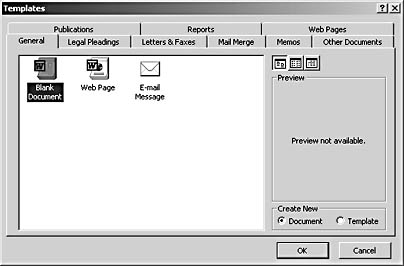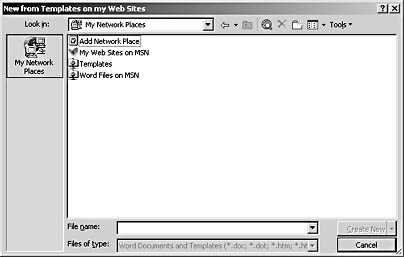Creating New Documents Based on Existing Templates
3 4
When you install Word, the setup program provides numerous wizards and templates. You can find additional wizards and templates on the Web, most notably by accessing the Microsoft Office Template Gallery (at http://officeupdate.microsoft.com/templategallery). With all these prebuilt templates at your disposal, you can easily create new documents based on templates without having to create a custom template. In this section, you'll learn how to create new documents based on templates that you have on hand or can access easily.
Troubleshooting
Some Built-In Word Templates Aren't Available
When Word is installed as part of a typical Office installation, some built-in wizards and templates are installed directly onto your computer, but other wizards and templates are loaded by the Windows Installer the first time you try to access them. If you click Customize instead of Install Now when you first run the setup program, you can choose to install additional templates and wizards at that time.
To make additional built-in templates available after Word is installed, follow these steps:
- Run the setup program, choose the Add Or Remove Features option, and click Next.
- In the Features To Install list, expand the Word section, and then expand Wizards And Templates to view the list of built-in wizards and templates.
- Click the Wizards And Templates down arrow, and choose Run All From My Computer on the drop-down menu. To install only a few additional templates and wizards, click the icon next to each wizard or template you want to add, and choose Run From My Computer.
- Click Update to install the wizards and templates.
By indicating that you want templates and wizards to run on your computer, you'll be able to access the templates and wizards easily, without having to run the Windows Installer program.
Using the Templates Dialog Box to Create New Documents
As mentioned, Word provides a number of built-in templates that you can use to create new documents. For easy access, Word displays links to templates in the New Document task pane. To access the Word templates, choose File, New to display the New Document task pane, and then click the General Templates link. The Templates dialog box will appear, as shown in Figure 22-1.

Figure 22-1. The Templates dialog box provides easy access to built-in Word templates as well as custom templates.
The Templates dialog box lets you access all default Word templates (which are stored in the location shown for the Workgroup Templates File Types entry when you choose Tools, Options and click the File Locations tab) as well as any templates you create and save in the ...Application Data\Microsoft\Templates folder. Each tab in the Templates dialog box indicates a subfolder. When you create or copy custom templates (as described in the section "Creating Custom Templates"), you can include your custom templates in the Templates dialog box by storing the files in the Templates folder.
To create a new document using a template stored in the Templates dialog box, follow these steps:
- Choose File, New to open the New Document task pane, and then click General Templates in the New From Template section.
- In the Templates dialog box, click the tab for the subfolder that contains the template you want to use for the new document.
- In the Create New section, make sure that Document is selected, and then double-click the template (or select the template, and click OK).
If you're opening a template or wizard that's located on your computer, Word immediately creates a new document. If the template isn't on your computer, Windows Installer loads it and then Word creates the document.
Tip - Access Word templates from the Start Menu
If you have Microsoft Office installed, you can open Word and a new document based on a template simultaneously. To do so, click Start, choose New Office Document, and then double-click any Word template displayed in the New Office Document dialog box.
Obtaining Templates from Microsoft.com
If you find that the Templates dialog box doesn't contain the template you need, you might want to download additional templates from the Microsoft Office Template Gallery Web site. Figure 22-2 shows some of the template categories available on the Office Template Gallery Web site.

Figure 22-2. In addition to clicking category headings to find templates, you can type a search string in the Office Template Gallery's Search For Templates box.
To use the Office Template Gallery, verify that you're connected to the Internet, and then follow these basic steps:
- Choose File, New, and then click the Templates On Microsoft.com link in the New Document task pane.
- On the Office Template Gallery Web page, click a main category or a subcategory listing, and then scan the available templates. To preview a template, click the Go To Preview hyperlink associated with the template. You might be asked to accept a template agreement; if so, click Accept to continue.
- When you find a template that suits your needs, click the Edit In Microsoft Word hyperlink.
The template will be downloaded to your system and displayed in Word. At that point, you can edit the template and save it as a local document or template. You should spend some time checking out the templates on the Office Template Gallery Web site—the selection is fairly extensive, ranging from marketing and business forms to stationery and résumés.
Using Templates Stored on Your Web Sites
In addition to retrieving templates from the Templates dialog box and the Office Template Gallery, you can access templates stored on a network or Web site. Frequently, workgroups need to share templates, so storing templates on line provides an ideal way to share templates and ensure that the most up-to-date templates are readily available to team members. In Word 2002, you can easily create new documents based on templates that are stored on Web sites and in networked locations. To do so, make sure you're connected to the Internet, and then follow these steps:
- Choose File, New, and then click the Templates On My Web Sites link in the New Document task pane. The New From Templates On My Web Sites dialog box opens, as shown in Figure 22-3.

Figure 22-3. The New From Templates On My Web Sites dialog box serves as a gateway to templates stored on your network or Web sites.
- Double-click the shortcut to the folder on the Web server that contains the template you want to use.
- If necessary, double-click the folder that contains the template you want to use, and then double-click the template file.
After you open an online template file, a new document is created on your desktop that's based on the template settings. You can then type the contents of the new file and save the document locally or store it on the server, just as you can any other document.
Troubleshooting
Links to Templates Are Not Displayed When I Click the Templates On My Web Sites Link
Before you can create a new document based on a template that's stored on line, the template must be stored in an online folder, and you need to create a shortcut to the network or Web server that contains the template you want to use. If these conditions aren't met, you won't have any Web site shortcuts in the New From Templates On My Web Sites dialog box.
If you don't have a Web site or network server space, you can obtain file storage space on line in a number of ways. Here are a couple of techniques for accessing free Internet space that you can use to store files:
- You can create a File Cabinet on the MSN Communities Web site, at http://communities.msn.com.
- You can access recommended entities providing free server space by visiting the Microsoft Office Update page (http://officeupdate.microsoft.com). On the Microsoft Office Update page, click the eServices hyperlink, and then click the Store Files On The Web hyperlink (which appears below the My Data On The Web hyperlink).
After you have created an online folder in which you can store files and templates, the next order of business is to create a shortcut to the online folder. To do so in Windows 2000, follow these steps:
- Click Add Network Place in the New Document task pane.
- In the Add Network Place Wizard, click Create A Shortcut To An Existing Network Place, and click Next.
- Type the URL of the Web server, type a name for the shortcut to the Web server, and then click Finish.
After you create shortcuts to Web site locations, you can click the links to the sites in the New From Templates On My Web Sites dialog box to access the online folder and any files or templates stored within the folder.
EAN: 2147483647
Pages: 337